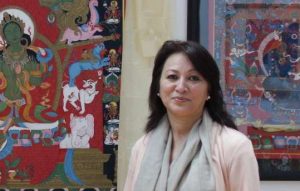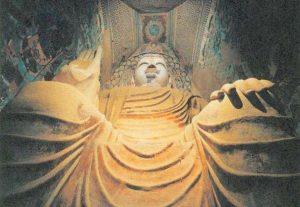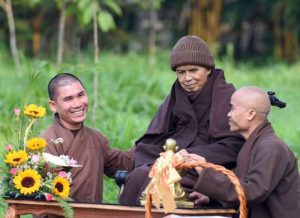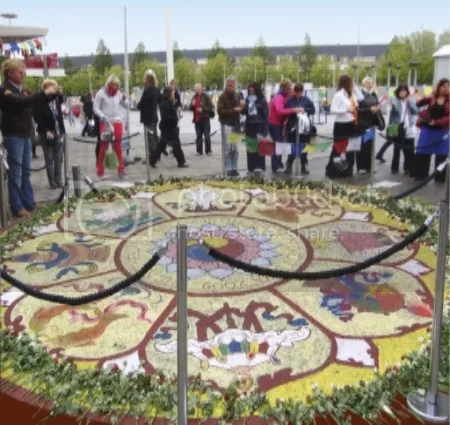
Dalai Lama in 2009
The Eight Auspicious Symbols, or Ashtamangala, are perhaps the most well-known group of symbols in Tibetan Buddhism. Consisting of the parasol, the pair of golden fish, the treasure vase, the white lotus, the conch shell, the endless knot, the victory banner, and the wheel of Dharma, these symbols are considered sacred signs of spiritual and material well-being by Tibetan Buddhists. They can be found adorning all manner of objects in Tibetan homes and monasteries, such as furniture, metalwork, and carpets.
In the Tibetan Buddhist tradition, a highly respected lama is welcomed to a monastery with a representation of the Eight Auspicious Symbols in the form of a painting, or using flour or colored powders. To my eternal gratitude, when His Holiness the Dalai Lama visited the Netherlands in 2009 and 2014, on both occasions I was asked by the events’ organizers to design depictions of the Eight Auspicious Symbols and to paint them.
I’d previously worked as an artist in advertising and the theater, but had already been drawing and painting thangkas—traditional scroll paintings of the Buddhas, mandalas, and teachings of Tibetan Buddhism—as a student of the acclaimed thangka artist Andy Weber. I studied under Andy, one of the first Western students of Tibetan thangka art, for a total of about 10 years after becoming a Buddhist in 1998 (I studied Buddhism with the Foundation for the Preservation of the Mahayana Tradition, where I’m now a regular teacher). In 2003, Andy told me it was time to start teaching thangka drawing and painting to others—something I’d never seen coming! Teaching thangka painting is much more than helping people paint a beautiful image as it involves guided meditation and explaining the Buddhist philosophy and symbolism behind the images—yet with no previous teaching experience I began instructing a small group of people in Amsterdam each month.
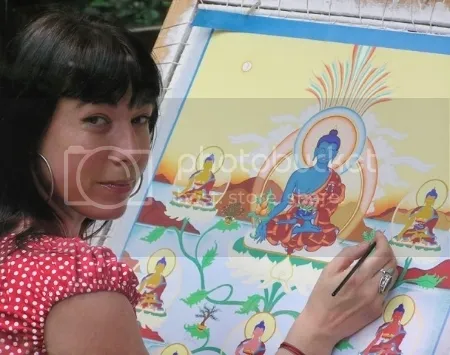
In the weeks leading up to the Dalai Lama’s visit to Amsterdam in 2009, I designed a 16.4-foot- (5-meter-) wide representation of a lotus flower with eight petals—one symbol in each petal. The day before the big event, I arrived at the venue early in the morning to draw out the basic design on the pavement in front of the event hall. Later in the day, some people came to help with the painting, and we worked together until late into the night. We painted from outside in, the traditional method that I also follow when painting thangkas. On this occasion, I chose to paint with loose pigment powder and water so that eventually the painting would wash away in the rain, signifying the impermanence of all phenomena, just as with the destruction of a sand mandala.
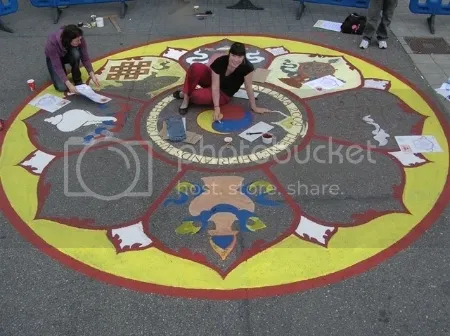
Netherlands
The next day, the Eight Auspicious Symbols painting welcomed not only HH the Dalai Lama, but also the 15,000 people that came to hear his teachings. At the end of this wonderful day, I even had the opportunity to offer His Holiness some my art. His Holiness asked if I had painted it myself, and when I said “yes,” he blessed it by placing it on his head. This precious moment and the blessing of the Dalai Lama himself felt like a stamp of approval for my work and confirmation that I was on the right track, both as an artist and as a teacher—it was exactly the encouragement I needed to go on.

After the event concluded and the audience had left, it began to rain. Outside, I saw that the painting was already starting to fade now that it had achieved its purpose. I was gratified to see that people had spontaneously placed roses and little thank-you notes before it in tribute to the Dalai Lama.
The five years that followed were no less eventful. I was unable to find work due to the global economic crisis, leaving me with no income, and despite feeling down, came to realize that this was a sign that I should commit myself 100 per cent to thangka painting and teaching in the Netherlands—a step I would otherwise never have dared to take as I hadn’t thought it possible to derive an income from it. I slowly grew more comfortable as a teacher by developing an approach based on how I would want to receive instruction myself: a combination of art, meditation, lectures, and Buddhist philosophy. I worked hard and soon started to receive invitations to teach in other countries in Europe—Germany, Italy, and Spain—the United States, and Asia—Malaysia and Singapore.
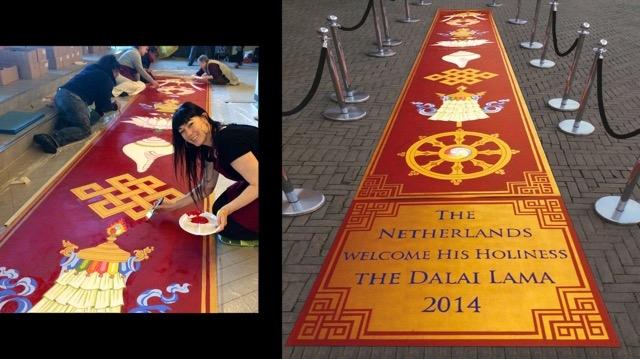
On the Dalai Lama’s subsequent visit to the Netherlands, in 2014 (Rotterdam, this time), I was once again asked to prepare a painting to welcome him, and in the preceding weeks, my assistant Romeo and I created another design of the Eight Auspicious Symbols. This time we designed a 30-foot- (9-meter-) long piece using special paint on canvas that would survive the bad weather that was forecast for the day.
The day before the Dalai Lama’s arrival, I invited ten of my thangka-painting students to help with this special piece. Starting early in the morning, we worked until late in the evening, painting with joy, laughter, and dedication. As predicted, the big day started out with plenty of rain, thunder, and a hard wind, so we had a difficult time placing the painting. Eventually we succeeded in mounting it in front of the main entrance to the venue, where it greeted the Dalai Lama and the 11,000 people who had come to the teachings. The same painting was used again earlier this year to welcome another great lama to the Netherlands, Lama Zopa Rinpoche.

I have since been asked to create similar large paintings for big spiritual festivals, which hundreds of visitors have contributed to bringing to life—young and old, with and without creative experience, some painting for five minutes, some for five hours. Their energy permeates these special works.
The Eight Auspicious Symbols have become a recognizable thread through my life, and have indeed been very auspicious for me. I now work harder than ever, and while I earn much less than before, I have a much greater sense of fulfillment and more joy in what I do. I travel around the world teaching courses, and new invitations continue to pop up, such as leading a 10-day thangka-painting retreat in Sri Lanka. It still amazes me to see how the lives of my students are inspired and enriched by the Buddhas, mandalas, and symbols they draw and paint—more than just beautiful images, they are living energies!

Art in New York
Carmen Mensink is a member of the Dakini As Art Collective. She is an internationally renowned painter of thangkas. Based in Amsterdam, Carmen teaches this beautiful art, as well as Buddhist meditation and philosophy, at museums, universities, and Buddhist centers around the world. To learn more about Carmen, her work, and Dakini As Art, please visit Dakini As Art.
See more




